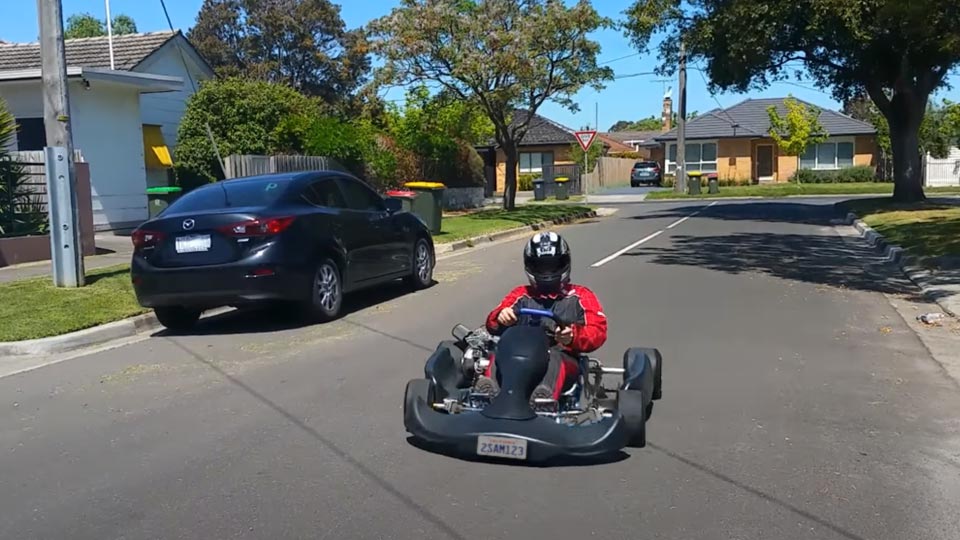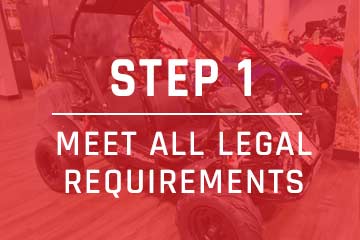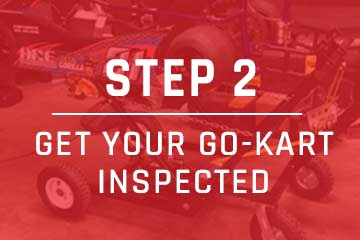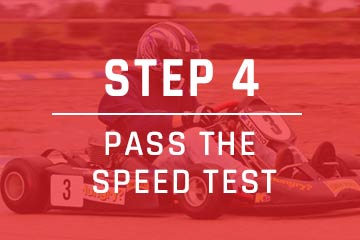We all use public roadways as a medium to help us reach our destination. While we mainly see cars and motorcycles on the road, you spot the occasional Low-Speed Vehicle (LSV), Off-Highway Recreational Vehicle (OHRV) or Off-Road Vehicle (ORV).
Public roadways are heavily regulated and you’re only allowed to drive street legal vehicles. It’s therefore uncommon to see any go-karts on the street, as they’re mostly designed to be driven on the race track or on off-road terrain.
However, this doesn’t mean that you can’t drive a go-kart on the street legally. In fact, you do spot the occasional off-road go-kart on public roadways. This is because some of these go-karts are suitable on streets and roadways and have gone through the proper procedures to be driven legally on the road.
Go-karts can be made street legal in some states, if they meet all the necessary requirements. In this article, I’ll guide you through a 5-step process on how to make a go-kart street legal.
Can You Make a Go-Kart Street Legal?
The short answer is, yes! You certainly can make a go-kart street legal. However, you should know that by default, racing and off-road go-karts are not allowed on public roads because they lack the necessary requirements to be operated on the street safely.
If you’re a go-kart enthusiast and your aim is to make your go-kart street legal, I’m happy to inform you that this is absolutely possible.
Many people judge go-karts as being unsafe to be driven on public roadways. This mainly stems from the fact that they aren’t equipped with the required safety gear and also due to their high speeds. It’s a valid concern and public and personal safety should always be regarded with the utmost importance.
This is also why your go-kart will need to comply with certain safety requirements, in order to make it street legal. Some states have varying roadway policies, go-kart laws and classifications that govern how go-karts qualify as an LSV, OHRV or ORV vehicle that can operate on the street.
In general, your go-kart would need to meet the following requirements:
- It has passed the various safety standards
- It’s fitted with the required safety equipment
- It’s been registered with the DMV
- The top speed is limited to 25 mph
- It has exactly four wheels
- It doesn’t exceed the weight limit of 3,000 lbs
- It’s been speed tested and inspected
- It has a required vehicle insurance
In essence, if you would like to ride your go-kart on the street, you’ll need to ensure that it meets all these requirements. If you’re planning to do this, then this article is suitable for you. We will go through a comprehensive step-by-step guide on how to make go-karts street legal.
Step 1: Ensure That Your Go-Karts Meets All Requirements
Before you’re able to register your go-kart, you’ll need to ensure that it’s in good condition and that it’s equipped with all the necessary parts. By doing so, you’re complying with your state or local go-kart laws and increase the chance of you being able to legally drive your go-kart on public roads.
There are a number of items that you may need to install. However, don’t think of it as a burden but rather that these parts will keep you and other drivers on the road safe and out of danger.
Below are the most essential parts that you should have installed on your go-kart before you proceed to register it. Please ensure to understand the local laws in your state so that you can pass the mandatory safety checks accordingly.
Also be aware of what vehicle classification your go-kart qualifies as. Generally speaking, their mostly considered Low-Speed Vehicles (LSVs), Off-Highway Recreational Vehicles (OHVs/OHRVs) or Off-Road Vehicles (ORVs).
- Brakes: A go-kart would need to have properly functioning brakes, which are in good condition. Worn or faulty brakes would automatically disqualify its roadworthiness. At high speeds, brakes are extremely crucial because they can prevent a possible crash from happening.
- Mirrors: Mirrors are an essential feature that go-karts must be equipped with. Side view mirrors must be correctly installed, so that you’ll have a full view of the activity behind you. They also help in overtaking and being aware of your immediate surroundings.
- Windshield: A windshield acts as a safety barrier from wind and foreign objects while driving. Ensure that the windshield is of high quality and is clear. Also take note that not all states require you to install a windshield and it’s therefore best to check with your local authorities.
- Seat Belts: One of the most important safety features of any vehicle are seat belts. In case of a collision, safety belts keep you inside the vehicle so that you won’t get flung out. If your go-kart doesn’t have them, you’ll need to install them separately.
- Horn: You’re also required to have a horn equipped on your go-kart. A horn has the ability to stop a potential accident and acts as a warning signal to other drivers.
- Tires: Tires need to be DOT approved and be in good condition. DOT tires are usually larger than standard racing or off-road go-kart tires. In some cases you may be required to change them before scheduling the inspection.
- Lights/Reflectors: All types of lights and reflectors, which include headlights, signal lights, brake lights and safety reflectors must be installed and functioning as designed. They not only indicate signaling or braking, but also help to illuminate dark roadways at night.
- Fluids: Check all the necessary fluids if they are at a good level. It will ensure that your vehicle is in tiptop shape and that all components are working as intended.
- Speedometer: A speedometer is required as this will tell you your current speed. This is important, as you’ll need to abide by the speed restrictions on the road.
- Exhaust System: Most 2-stroke engines are relatively loud. A proper muffler and exhaust system helps to reduce the noise levels. Take note that some states may require you to have a catalytic converter.
Step 2: Get Your Go-Kart Inspected:
In most states, the process of making a go-kart street legal will require a full inspection by an appointed officer of the DMV. These inspections are an essential part of ensuring that your go-kart is in good condition and is equipped with all the necessary components to make it street legal.
There is no way around a thorough inspection and the inspection officer will detail all the required parts and check if your go-kart is compliant with regulations. You should think of this positively, as he or she will ensure that you have all the necessary safety equipment installed for safe driving on public roads.
The necessary requirements can differ from state to state and if the inspection officer notices any essential parts missing, you’ll have to take the vehicle back and install the missing parts accordingly, in order to pass the inspection test.
I would therefore always recommend reading up on your state and city requirements first, before sending your go-kart for inspection. You can do this at your local DMV, by reading the requirements of Low-Speed, Off-Highway Recreational Vehicles or Off-Road Vehicles.
Step 3: Pass the Speed Test
The next step in the process of making your go-kart street legal is a speed check. Before being able to officially register your go-kart, an officer needs to ensure that the vehicle is safe to drive on public roads. This is where the speed test comes in.
Most states stipulate a maximum speed of 25 mph for all LSV and OHRV vehicles such as go-karts. Some states enforce that your vehicles must not be able to exceed these speeds.
This means that in some states you may be required to have a speed governor installed. A speed governor, also called a speed limiter, ensures that your go-kart isn’t able to exceed the set speed. In this case you’ll want to set the limit at 25 mph or lower.
Be prepared that an inspection officer will physically test the speed of your go-kart to ensure that you’re adhering to the LSV and OHRV requirements and laws.
Step 4: Register Your Go-Kart
Once you’ve taken the necessary steps by having installed all the required parts, gotten your go-kart inspected and passed the speed test, you can now proceed to register your go-kart. Go-karts are typically registered as Low-Speed Vehicles (LSV), off-highway recreational vehicles (OHRV) or Off-Road Vehicles (ORV).
The vehicle classification depends on the city or state that you’re residing in. Inquire the vehicle classification of your go-kart with your local DMV.
Registration Requirements
Bear in mind that there are also certain limitations to registering your go-kart. Most commonly, there’s a weight limitation of 3,000 lbs. Your go-kart must have four wheels and a speed limitation of 25 mph. Here’s a quick summary:
- Go-Kart Equipment: All required parts
- Go-Kart Weight: Less than 3,000 lbs
- Go-Kart Speed: Not more than 25 mph
- Go-Kart Wheels: Exactly four
Registration Documents
There are several documents you’re required to submit to complete the registration process at your DMV. The exact list may differ from state to state, but below is a general list that you can use as a guideline. It’s usually a combination of a few or all items below:
- Title of the go-kart
- Bill of Sale (indicating sell price and VIN)
- Valid driver’s license
- Government-issued ID
It’s best to prepare these documents in advance, before registering your go-kart. In general, the DMV will need to assess if you’re the legal owner of the vehicle, that you’re of legal driving age and that you are able to present your personal details. You can read more information on go-kart titles if you’re interested.
Once you’re issued the registration certificate and receipt, ensure that you keep all documents in a safe place so that you can summon them when pulled over on the road and for further reference, such as insurance registration. Some areas require you to have vehicle insurance coverage beforehand. Ensure to check this with your local DMV.
Step 5: Get a Go-Kart Insurance
Almost all states require vehicle insurance, apart from New Hampshire and Virginia. It may differ for LSVs and OHRVs. However, it’s always recommended to have vehicle insurance, as it gives you peace of mind when driving your go-kart on the streets. It can also safeguard your liability in unwanted scenarios that include:
- Accidents on the road
- When your go-kart is stolen
- Third party liabilities
Those scenarios are usually covered in typical LSV OHRV insurance. Finding go-kart insurance can be tricky. Most of the auto insurance companies won’t necessarily cover go-karts and you’ll need to find a company that can insure your go-kart.
You can learn more about go-kart insurance, in order to establish which type of insurance is most suitable for you. Please bear in mind that you’re required to fill out and bring along most of the information that you required when registering your go-kart.
As previously stated, also be mindful that some states require you to already have insurance coverage before you’re able to register your go-kart. It’s always best to check with your local DMV beforehand.
Conclusion
Owning and racing go-karts is a lot of fun and you can easily develop a passion for it. For some, it goes so far that they want to drive their go-kart wherever they go, which is completely understandable. It’s also easy to see that the most suitable location for racing go-karts is on race tracks and off-road terrain for off-road go-karts. However, it’s possible to make go-karts street legal, in order to drive them on public roadways.
Racing go-karts require a lot of modifications, in order to pass the street legal test and are therefore best kept on the race track. A better case can be made for off-road go-karts which already contain most of the required parts in order to pass the DMV inspection. In fact, you’ll only need to upgrade and add a few parts, in order to make an off-road go-kart street legal.
Please always keep in mind that you must always ensure to check all the exact requirements with your state’s DMV and prepare all documentation in advance.
Once you have made your go-kart legal it’s important to always abide by the local go-kart laws and regulations and always drive safely. I hope that this guide was able to impart you with the information you were looking for and that this comprehensive guide was useful to you. If you’re planning on registering your go-kart, I wish you the best of luck and be safe on the roads!







Thank you for the friendly and thorough explanation! I’d like to ask, how to proceed it I am building a go kart from scratch (i.e., I am buying the motor, wheels, steel for frames, etc.).
One complication is I wouldn’t be able to show any sort of VIN because I am not buying the vehicle. What documentation is needed in my case? Another complication is that if I make my own speedometer, will the DMV trust it?
Would you be able to recommend anything else?
Hi Ilya, thanks for the kind words. This may be a tough one but worth a try if your state is open to that.
Check out the go-kart laws in your state and then get in touch with your county’s DMV.
Typically you’ll need a title, valid driver’s license and a government-issued ID. They should be able to guide you!